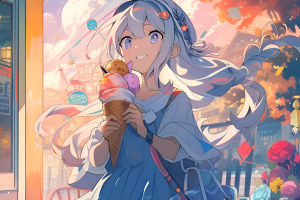Hello Lykkers! In today's digital age, colors dominate much of the media we consume, shaping moods and enhancing narratives. However, an intriguing artistic choice is making a strong comeback — the use of black and white.
This classic style offers a unique way to convey emotions, highlight contrasts, and evoke nostalgia.
Let's explore how black and white imagery is being creatively employed in films, series, and even video games, and why it remains a powerful storytelling tool.
The Artistic Revival of Black and White
Elegant Simplicity and Emotional Depth
Many creators have chosen black and white to craft stories that feel pure and elegant. Unlike the grainy look of early cinema, contemporary productions use clean, bright monochrome visuals that bring a fresh, sophisticated appeal.
This approach can immerse viewers in intimate personal worlds, emphasizing emotional subtleties. For example, in a well-known film that follows a young woman's daily life, the clean monochrome style highlights her gentle nature and sacrifices, separating her visually from the more privileged circles around her.
Capturing Intimacy and Historic Moments
The monochrome palette is often used to amplify emotional connections in love stories set in tense historical periods. It not only reflects the time but also draws attention to facial expressions and physical gestures, deepening immersion into the unfolding drama.
This technique helps bridge past and present emotions, making the story resonate on multiple levels. The use of black and white in such narratives enhances a sense of authenticity and foreshadows inevitable outcomes with subtle visual cues.
Black and White Beyond the Big Screen
Documentary Storytelling and Social Commentary
Recent works use monochrome visuals to blend historical and contemporary social themes. This choice honors past filmmaking styles and sheds light on ongoing societal challenges, particularly around inequality and justice.
By presenting these stories in black and white, filmmakers create a timeless connection, inviting viewers to reflect on enduring issues without distraction from color.
Mixed Visual Techniques for Narrative Clarity
Some productions combine full color with monochrome sequences to distinguish between subjective experiences and objective events. For example, courtroom scenes may be shown in stark black and white, grounding the narrative in impartial reality. This contrast between color and monochrome guides the audience's perception, reinforcing the story's emotional and factual layers.
Monochrome in Television Series
The style is also prominent in television, where creators draw inspiration from classic noir aesthetics. This vintage look emphasizes atmospheric settings and supports intense character studies. By focusing on shadow and light, black and white visuals enhance the intimacy of performances, making the viewing experience more engaging.
Expanding into Interactive Media
Black and White in Video Games
The monochrome aesthetic extends beyond films and shows into gaming, where it adds a retro, nostalgic flavor. Games featuring grainy textures and minimalistic designs evoke classic cartoons or old film reels, creating a unique mood.
Soundtracks with vintage tones complement the visuals, enhancing the immersive experience. This style not only stands out visually but also contributes to storytelling by reinforcing themes of suspense and mystery in gameplay.
Why Black and White Remains Popular
Intellectual Appeal and Artistic Legitimacy
Streaming platforms have supported monochrome projects to boost their reputation for high-quality, artistic content. This investment highlights the genre's intellectual appeal and provides audiences with a different cinematic experience.
Notable titles in black and white have received major awards, signaling a shift in how these platforms value such productions.
A Nod to Classic Cinema
Some directors playfully adopt black and white to associate their work with timeless classics. This choice can elevate the perception of their films, linking them to a revered tradition and inviting viewers to reconsider their value. The monochrome look suggests sophistication and depth, encouraging audiences to appreciate the art beyond surface appearances.
Retro Aesthetics and Social Media Trends
The vintage charm of black and white aligns well with current trends on social networks, where filters recreate old-fashioned styles for photos and videos. This renewed interest in retro visuals shows how monochrome aesthetics resonate with modern audiences, offering a nostalgic yet fresh look that stands out in a colorful digital world.
Conclusion: More Than Just Style
Black and white imagery is far from obsolete. It remains a powerful means of emphasizing contrast, focusing attention on details, and evoking deep emotional responses. Beyond simply replacing color, monochrome offers a poetic dimension that connects viewers with the roots of visual storytelling.
As it continues to inspire filmmakers, series creators, and game developers alike, black and white proves its timeless value as an artistic choice. For Lykkers seeking authentic and elegant narratives, this style offers a window into a world where light and shadow tell stories that words alone cannot.


